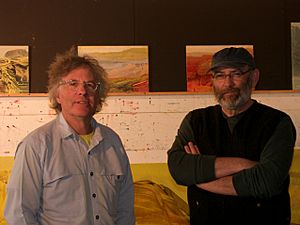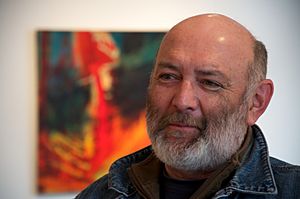James Lavadour facts for kids
Quick facts for kids
James Lavadour
|
|
|---|---|

James Lavadour (right) with Spencer B. Beebe of Ecotrust
|
|
| Born |
James Lavadour
1951 (age 73–74) |
| Education | Self-taught |
| Known for | Painting, printmaking |
James Lavadour, born in 1951, is a talented American artist. He is known for his amazing landscape paintings and prints. James is a member of the Walla Walla tribe. He also helped start the Crow's Shadow Institute of the Arts, an art center.
I believe that a painting must stand up on its own without explanation. I think of myself as an abstract action painter. I just happen to see landscape in the abstract events of paint. - James Lavadour
Contents
About James Lavadour
I'm a tribal member and grew up on the Umatilla reservation, and I love it there. One of the aspects of tribal life is that the land and I are one. - 2005
Early Life and Inspiration
James Lavadour was born in 1951 in Pendleton, Oregon. His family has roots from many different groups, including Chinook, Walla Walla, German, Irish, Assiniboine, and French Canadian.
James loved painting from a young age. Even though he didn't finish high school, his family encouraged his art. A big inspiration for him was the peeling, water-stained ceiling of his grandmother's house. He called it "The Sistine Chapel" because its layers and drips influenced his art forever.
When he was young, his parents worked at the Washington State Penitentiary in Walla Walla. James worked many jobs, like a delivery boy, canner, janitor, carpenter, and even a firefighter. He didn't get formal art training. Instead, he learned about art and culture from books. He studied artists like Charles Marion Russell and J. M. W. Turner. He was especially interested in Chinese and Asian art, which taught him about the energy of making art.
Professional Life and Nature
James Lavadour started showing his art in Seattle, Washington in the 1970s. His first big shows were with Sacred Circle, a Native American art gallery.
James loves to hike in the mountains near his home. These outdoor adventures continue to inspire his artwork today.
James Lavadour's Art Career
I use two elemental structures, a landscape and an architectural abstraction (a vortex and a grid). There's the flow of landscape and then the intersection of the architectural structure, which is just like being in a room looking out a window, with floors, angles, walls, doors, ceilings, pathways. A painting is a complex event with many things going on at multiple levels. Close, far, color, layers, scrapes, and drips all swirled around by memories. I keep it all organized with structure. Structure is the bed to the river.
- James Lavadour
Lavadour doesn't try to make his art mean something specific. He believes it just becomes something. He says this idea comes from his connection to nature and growing up on the Umatilla reservation.
Early Paintings
James learned art mostly by himself. He explored the land around the Umatilla Indian Reservation and Western Oregon. His early works often looked like German romanticism. They showed how much geology and landscapes affected his art. He used mostly one color (monochromatic) in these abstract pieces, which he called his Interiors. These Interiors were like hazy, painted photographs with streaks of color. They were described as "emotional interpretations of the land."
Current Artworks
In the 1990s, Lavadour began to explore printmaking. He combined printmaking with his painting, which led to amazing layered effects in his new works. These layers make the landscapes look like maps or as if they are moving. His newer art has been compared to the work of Gerhard Richter.
He also started exploring other ideas, inspired by Chinese painting, abstract expressionism, and jazz music (especially John Coltrane). However, landscapes are still the main focus of his art.
Lavadour often uses multiple panels in his work. He places these panels together to create a wide view, like a panorama. This allows viewers to explore the environment through his unique artistic vision. James Lavadour's art is shown at PDX Contemporary Art in Portland.
How He Creates Art
James wakes up around 3:00 AM every morning to work in his studio. His studio is on the Confederated Tribes of the Umatilla Indian Reservation. Music, especially jazz from artists like John Coltrane, Sun Ra, and Miles Davis, inspires and motivates him.
Lavadour's process usually involves putting on layers of paint, then scraping or wiping them away. This is like how nature erodes landscapes. He believes his art has two main parts: capturing the layers and shapes of the physical scenery, and exploring the energy and emotions of that scenery. This helps him discover how the paint moves on the canvas, rather than just focusing on colors.
Crow's Shadow Institute of the Arts
In 1990, James Lavadour helped start the Crow's Shadow Institute of the Arts. This non-profit art group brings "technology, instruction and cultural exchange" to artists on the Umatilla Indian Reservation. He was inspired to create this center after his own experiences as an artist at Rutgers University.
Art in Collections
- Whitney Museum of American Art
- Denver Art Museum
- Heard Museum
- Indian Arts and Crafts Board
- National Museum of the American Indian
- Qwest Corporation
- Seattle Arts Commission
- Washington State Arts Commission
- Eiteljorg Museum of American Indians and Western Art
- Bank of America
- Boise Art Museum
- Ecotrust
- Hilton
- Microsoft
Major Art Exhibitions
- Stretching the Canvas: Eight Decades of Native Painting, 2019–21, National Museum of the American Indian George Gustav Heye Center
- Venice Biennale, collateral exhibition, 2013
- Vantage Point, 2010, National Museum of the American Indian
- James Lavadour: The Properties of Paint, 2008, Hallie Ford Museum of Art
- A Sense of Place: Selections from the Tacoma Art Museum Collection, 2005, Tacoma Art Museum
- Into the Fray: The Eiteljorg Fellowship for Native American Fine Art, 2005, Eiteljorg Museum of American Indians and Western Art
- Lewis and Clark Territory: Contemporary Artists Revisit Place, Race and Memory, 2005, Tacoma Art Museum
- Site Unseen: A Contemporary Look at Landscape, 2005, Savannah College of Art and Design
- Seattle Perspective, 2004, Seattle Convention Center
- 2003 Oregon Biennial, 2003, Portland Art Museum
- Solo exhibition, 2002, Maryhill Museum of Art
- Solo exhibition, 2001, Northwest Museum of Arts and Culture
- Solo exhibition, 1998, Pacific Northwest College of Art
- Land, Spirit, Power, 1992, National Gallery of Canada (NGC)
- Solo exhibition, 1990, Portland Art Museum
- Solo exhibition, 1990, Boise Art Museum
Lavadour has also shown his art at many private galleries.
Awards and Honors
- Eiteljorg Fellowship, 2005, Eiteljorg Museum of American Indians and Western Art
- Honorary Doctorates in Humane Letters, 1999, Eastern Oregon University
- Joan Mitchell Fellowship for Painting, 1998, Joan Mitchell Foundation
- Rutgers Center for Innovative Print Making Fellow, 1995, Rutgers University
- Oregon Governor's Arts Award, 1994
- Betty Bowen Award, 1991, Seattle Museum of Art


